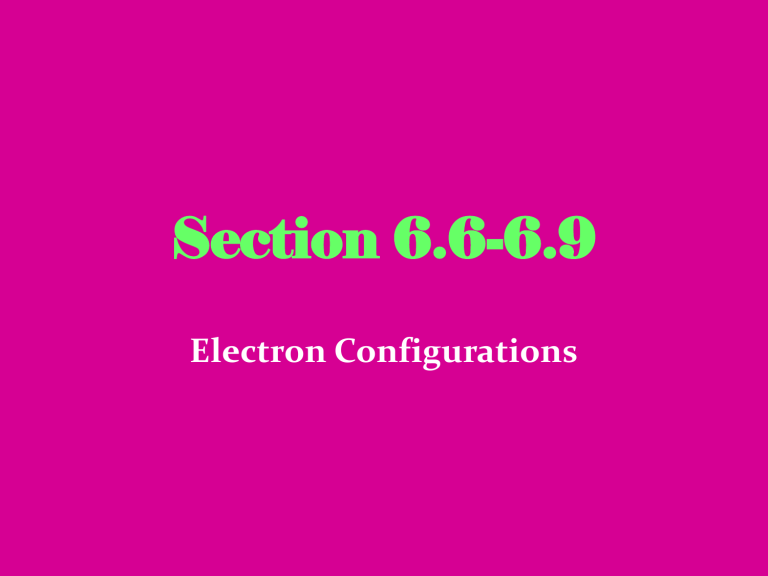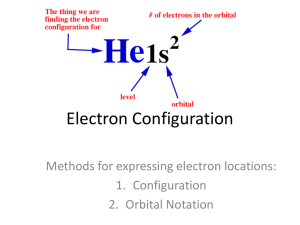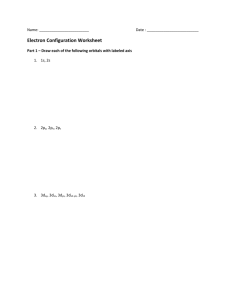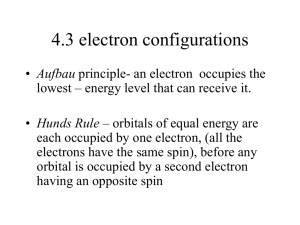Sections 6.6-6.9

Section 6.6-6.9
Electron Configurations
Objectives
• Arrange electrons in atoms
• Describe quantum mechanics in terms of atomic orbitals
• Identify characteristics of electrons described by various laws of physics
Electron Configurations
• Electron location when atom is in the ground state
• 3 rules or laws
– The Aufbau principle
– Pauli Exclusion principle
– Hund’s Law
Aufbau Principle
• Electrons occupy lowest energy orbital available
– All orbitals of a sublevel are equal energy
– Sublevels within a principal energy level have different energies.
• Ex: 3p orbitals have higher energy than
2s orbital.
Aufbau (cont.)
– In order of increasing energy within a principal energy level is s, p, d, and f.
– Orbitals within one principal energy level can overlap orbitals of another
• Ex: 4s orbitals are lower energy than 3d orbitals.
Electron Configurations
Electron Filling Order
Which orbital will fill first, 4s or 3d?
Periodic Table Helps!
Pauli Exclusion Principle
– Maximum of 2 electrons in an orbital, but only if they have opposite spin.
Hund’s rule
– Electrons with same spin must occupy each equal energy orbital before additional electrons with opposite spins can occupy the same orbital.
Summarizing the 3 Rules
• Orbital filling order:
1s 2s 2p 3s 3p 4s 3d 4p 5s 4d 5p 6s 4f 5d 6p 7s 5f 6d 7p
Remember…
• How many electrons each orbital can hold:
• s = 2
• p = 6
• d = 10
• f = 14
Electron Configurations
• Four methods
1. Electron Configuration Notation
2. Noble Gas Notation
3. Orbital Diagrams
4. Electron-Dot Diagrams
Electron Configuration
Notation
• Describes arrangement of electrons in atoms
• Designates principal energy level and sublevel associated with each orbital
• Superscript represents number of electrons in orbital
Electron Configuration Notation
• Ex: Write the electron configuration notation for Nitrogen.
–
Number of electrons?
•
Start with the 1s orbital and fill it with 2 electrons, then the 2s orbital gets 2 electrons, then the 2p orbital gets the remaining 3 electrons
–
1s 2 2s 2 2p 3
–
The superscripts should add up the total number of electrons in the element.
Electron Configuration Notation
• You try … Zinc
Electron Configuration Notation
• Answer:
1s 2 2s 2 2p 6 3s 2 3p 6 4s 2 3d 10
Assignment
• Write the electron configuration notation for the following elements:
– Boron (B), Neon (Ne), Sulfur (S),
Magnesium (Mg), Vanadium (V),
Arsenic (As), Silver (Ag), Bromine
(Br), Promethium (Pm) and Gold (Au)
Noble Gas Notation
• Shorthand configuration
– Find the noble gas closest to the element (without going over).
– Ex: For gold (79) that noble gas would be Xenon (54)
– We write [Xe] and start counting from there
– The first orbital after xenon is 6s so that’s where we start
Noble Gas Notation
• [Xe]6s 2 4f 14 5d 9
• Check: (Xe’s atomic number) 54 + 2 + 14
+ 9 = 79 (gold’s Atomic number)!
Assignment
•Noble gas configurations for:
• Mn
• Kr
• P
• Zn
• Zr
• W
• Pb
• Ra
• Sm
• Bk
Orbital Diagrams
• Show the orbital distributions of electrons related to a sublevel
• Include a box for each orbital
• = orbital with 1 electron
• = orbital with 2 electrons
• Dashed lines can be substituted for boxes
Orbital Diagrams
• Nitrogen: 1s 2 2s 2 2p 3
– We start by writing the orbitals for Nitrogen
1 s 2 s 2 p 2 p 2 p
– Then we fill them with electrons using the Aufbau principle, Pauli exclusion principle, and Hund’s law
1 s 2 s
2 px 2 py 2 pz
Orbital Diagrams
• You try another example: Cu – 29 electrons
Orbital Diagrams
• Answer
1 s 2 s 2 p 2 p 2 p 3 s 3 p 3 p 3 p 4 s 3 d 3 d 3 d 3 d 3 d
Assignment
• Orbital Notation for:
– Beryllium
– Aluminum
– Nitrogen
– Sodium
Electron Dot Structures
• Valence electrons : electrons in outermost energy level.
– Responsible for chemical and some physical properties
– Number of electrons that still need to be filled after starting a noble gas notation.
• Ex: S = [Ne] 3s 2 3p 4 has 6 valence electrons
Electron Dot Structures
• Represents the valence electrons for that element
• Place ‘dots’ around the elements symbol
• 4 sides of the element are orbitals
• Fill these orbitals one at a time according to Hund’s law
Electron Dot Structures
Assignment
• Electron Dot Structures for:
– Carbon
– Arsenic
– Polonium
– Potassium
– Barium





